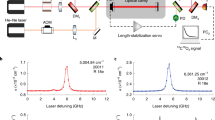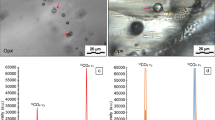Abstract
Major trends of Quaternary global climate are reflected in the continental ice volume changes which have been reconstructed by oxygen-isotope analysis1,2. δ18O records from deep-sea sediments show that the net glacial build-up occurs relatively slowly3, but that the end of an ice age occurs quickly, in less than 10,000 yr, implying a nonlinear response4,5 to simple Milankovitch theory6. The latter observation suggests that the cause of the most recent deglaciation was the maximum in summer calorific radiation at the upper latitudes of the Northern Hemisphere centred around 11,000 yr ago, a view supported by early studies7. Later work has produced conflicting dates, the main source of confusion being problems with obtaining accurate and reliable dates. Here, by using accelerator mass spectrometry, we have measured 14C for various species of foraminifera to produce a reliable timescale for the oxygen-isotope record. Our results show that, at the end of the last ice age, continental ice sheets began to melt more than 4,000 yr before the Northern Hemisphere maximum of summer calorific radiation.
This is a preview of subscription content, access via your institution
Access options
Subscribe to this journal
Receive 51 print issues and online access
$199.00 per year
only $3.90 per issue
Buy this article
- Purchase on Springer Link
- Instant access to full article PDF
Prices may be subject to local taxes which are calculated during checkout
Similar content being viewed by others
References
Emiliani, C. J. Geol. 63, 538–578 (1955).
Shackleton, N. J. & Opdyke, N. D. Quat. Res. 3, 39–55 (1973).
CLIMAP. Science 191, 1131–1137 (1976).
Hays, J. D., Imbrie, J. & Shackleton, N. J. Science 194, 1121–1132 (1976).
Imbrie, J. & Imbrie, J. Z. Science 207, 943–953 (1980).
Milankovitch, M. R. Serbian Acad. (Beograd) Spec. Publ. 133 (1941).
Broecker, W. S., Ewing, M. & Heezen, B. C. Science 258, 429–448 (1960).
Duplessy, J. C., Delibrias, G., Turon, J. L., Pujol, C. & Duprat, J. Palaeogeogr., Palaeo-climatol., Palaeoecol. 35, 121–144 (1981).
Ruddiman, W. F. & Duplessy, J. C. Quat. Res. 23, 1–17 (1985).
Berger, W. H. Sver. geol. Unders. Afh. 76 (7c), 270–280 (1982).
Mix, A. C. & Ruddiman, W. F. Quat. Res. (in the press).
Berger, W. H., Killingly, J. S., Metzler, C. V. & Vincent, E. Quat. Res. 23, 258–271 (1985).
Sarnthein, M., Erlenkeuser, H. & Zahn, R. Bull. Inst. geol. Basin d'Aquitaine, Bordeaux 31, 393–407 (1982).
Pujol, C. thesis, Univ. Bordeaux 1 (1980).
Ruddiman, W. F. & Mclntyre, A. Palaeogeogr., Palaeoclimatol., Palaeoecol. 35, 145–214 (1981).
Labeyrie, L. D. & Duplessy, J. C. Palaeogeogr., Palaeoclimatol, Palaeoecol. 50, 217–240 (1985).
Arnold, M., Lesueur, R., Maurice, P. & Duplessy, J.C. 3rd int. Symp. Accelerator Mass Spectrometry: AMS '84, Zurich (1984).
Vogel, J. S., Southon, J. R., Nelson, D. E. & Brown, T. A. Nucl. Instrum. Meth. 223, 289–293 (1984).
Beukens, R. P. & Lee, H. W. Symp. Accelerator Mass Spectrometry, Proc. Argonne National Lab. ANL/PHY-81-ln, 416–425 (1981).
Andree, M. et al. Nuclear Instruments and Methods in Physics Research B5, 340–345 (1984).
Berner, W., Stauffer, B. & Oeschger, H. Radiocarbon 22, 227–235 (1980).
Delmas, R. J., Ascencio, J-M & Legrand, M. Nature 284, 155–157 (1980).
Shackleton, N. J. & Pisias, N. G. in The Carbon Cycle and Atmospheric CO2: Natural Variations Archean to Present (eds Sundquist, E. T. & Broecker, W. S.) 303–317 (Am. Geophys. Un., Washington, DC, 1985).
Paterson, W. S. B. Rev. Geophys. Space Phys. 10, 885–917 (1972).
Grousset, F. & Duplessy, J. C. Mar. Geol. 52, M11–M17 (1983).
Denton, G. H. & Hughes, T. The Last Great Ice Sheets (Wiley-Interscience, New York, 1981).
Author information
Authors and Affiliations
Rights and permissions
About this article
Cite this article
Duplessy, JC., Arnold, M., Maurice, P. et al. Direct dating of the oxygen-isotope record of the last deglaciation by 14C accelerator mass spectrometry. Nature 320, 350–352 (1986). https://doi.org/10.1038/320350a0
Received:
Accepted:
Issue Date:
DOI: https://doi.org/10.1038/320350a0
This article is cited by
-
Resuscitation of anammox bacteria after >10,000 years of dormancy
The ISME Journal (2019)
-
Reconstruction of Caribbean climate change over the past 10,500 years
Nature (1991)
-
Calibration of the 14C timescale over the past 30,000 years using mass spectrometric U–Th ages from Barbados corals
Nature (1990)
-
Evidence for two-step deglaciation and its impact on North Atlantic deep-water circulation
Nature (1990)
-
A 17,000-year glacio-eustatic sea level record: influence of glacial melting rates on the Younger Dryas event and deep-ocean circulation
Nature (1989)
Comments
By submitting a comment you agree to abide by our Terms and Community Guidelines. If you find something abusive or that does not comply with our terms or guidelines please flag it as inappropriate.



